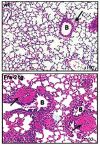A process-based review of mouse models of pulmonary hypertension
- PMID: 23372926
- PMCID: PMC3555412
- DOI: 10.4103/2045-8932.105030
A process-based review of mouse models of pulmonary hypertension
Abstract
Genetically modified mouse models have unparalleled power to determine the mechanisms behind different processes involved in the molecular and physiologic etiology of various classes of human pulmonary hypertension (PH). Processes known to be involved in PH for which there are extensive mouse models available include the following: (1) Regulation of vascular tone through secreted vasoactive factors; (2) regulation of vascular tone through potassium and calcium channels; (3) regulation of vascular remodeling through alteration in metabolic processes, either through alteration in substrate usage or through circulating factors; (4) spontaneous vascular remodeling either before or after development of elevated pulmonary pressures; and (5) models in which changes in tone and remodeling are primarily driven by inflammation. PH development in mice is of necessity faster and with different physiologic ramifications than found in human disease, and so mice make poor models of natural history of PH. However, transgenic mouse models are a perfect tool for studying the processes involved in pulmonary vascular function and disease, and can effectively be used to test interventions designed against particular molecular pathways and processes involved in disease.
Keywords: mouse models; pulmonary hypertension; vascular remodeling.
Conflict of interest statement
Figures



Similar articles
-
Induction and Characterization of Pulmonary Hypertension in Mice using the Hypoxia/SU5416 Model.J Vis Exp. 2020 Jun 3;(160). doi: 10.3791/59252. J Vis Exp. 2020. PMID: 32568218
-
Dynamic and diverse changes in the functional properties of vascular smooth muscle cells in pulmonary hypertension.Cardiovasc Res. 2018 Mar 15;114(4):551-564. doi: 10.1093/cvr/cvy004. Cardiovasc Res. 2018. PMID: 29385432 Free PMC article. Review.
-
NMDA-Type Glutamate Receptor Activation Promotes Vascular Remodeling and Pulmonary Arterial Hypertension.Circulation. 2018 May 29;137(22):2371-2389. doi: 10.1161/CIRCULATIONAHA.117.029930. Epub 2018 Feb 14. Circulation. 2018. PMID: 29444988
-
Experimental and transgenic models of pulmonary hypertension.Compr Physiol. 2011 Apr;1(2):769-82. doi: 10.1002/cphy.c100003. Compr Physiol. 2011. PMID: 23737202 Review.
-
The FGL2 prothrombinase contributes to the pathological process of experimental pulmonary hypertension.J Appl Physiol (1985). 2019 Dec 1;127(6):1677-1687. doi: 10.1152/japplphysiol.00396.2019. Epub 2019 Oct 3. J Appl Physiol (1985). 2019. PMID: 31580221
Cited by
-
Pathological changes in pulmonary circulation in carbon tetrachloride (CCl4)-induced cirrhotic mice.PLoS One. 2014 Apr 24;9(4):e96043. doi: 10.1371/journal.pone.0096043. eCollection 2014. PLoS One. 2014. PMID: 24763616 Free PMC article.
-
Repetitive sulfur dioxide exposure in mice models post-deployment respiratory syndrome.Am J Physiol Lung Cell Mol Physiol. 2024 May 1;326(5):L539-L550. doi: 10.1152/ajplung.00239.2023. Epub 2024 Feb 27. Am J Physiol Lung Cell Mol Physiol. 2024. PMID: 38410870 Free PMC article.
-
Single-Cell RNA Sequencing Reveals Novel Genes Regulated by Hypoxia in the Lung Vasculature.J Vasc Res. 2022;59(3):163-175. doi: 10.1159/000522340. Epub 2022 Mar 16. J Vasc Res. 2022. PMID: 35294950 Free PMC article.
-
Group 3 Pulmonary Hypertension: From Bench to Bedside.Circ Res. 2022 Apr 29;130(9):1404-1422. doi: 10.1161/CIRCRESAHA.121.319970. Epub 2022 Apr 28. Circ Res. 2022. PMID: 35482836 Free PMC article. Review.
-
CrossTalk proposal: The mouse SuHx model is a good model of pulmonary arterial hypertension.J Physiol. 2019 Feb;597(4):975-977. doi: 10.1113/JP275864. Epub 2018 Nov 29. J Physiol. 2019. PMID: 30499212 Free PMC article. No abstract available.
References
-
- Simonneau G, Robbins IM, Beghetti M, Channick RN, Delcroix M, Denton CP, et al. Updated clinical classification of pulmonary hypertension. J Am Coll Cardiol. 2009;54:S43–54. - PubMed
-
- Stenmark KR, Meyrick B, Galie N, Mooi WJ, McMurtry IF. Animal models of pulmonary arterial hypertension: The hope for etiological discovery and pharmacological cure. Am J Physiol Lung Cell Mol Physiol. 2009;297:L1013–32. - PubMed
-
- Humbert M, Sitbon O, Yaïci A, Montani D, O’Callaghan DS, Jaïs X, et al. Survival in incident and prevalent cohorts of patients with pulmonary arterial hypertension. Eur Respir J. 2010;36:549–55. - PubMed
Grants and funding
LinkOut - more resources
Full Text Sources

